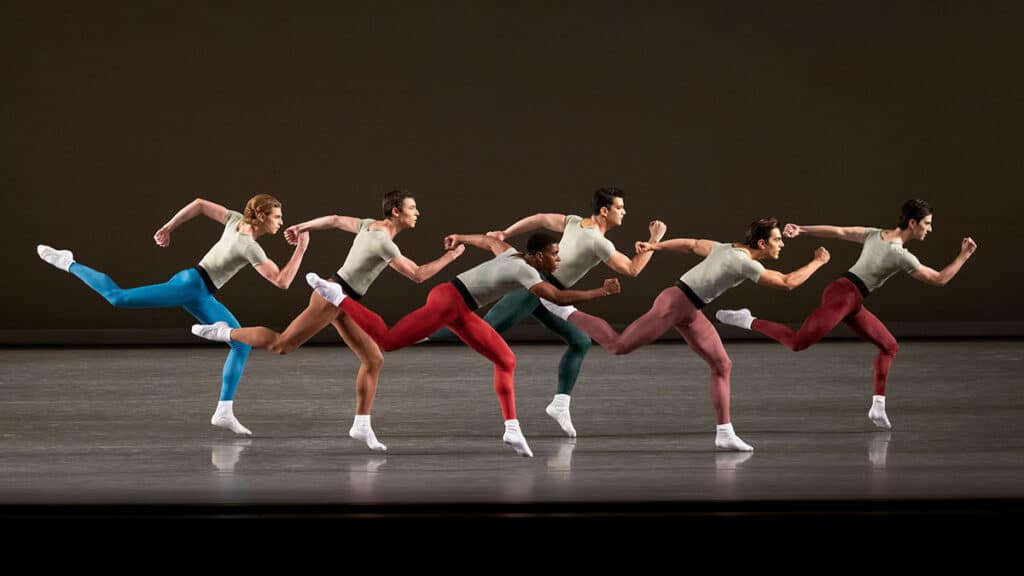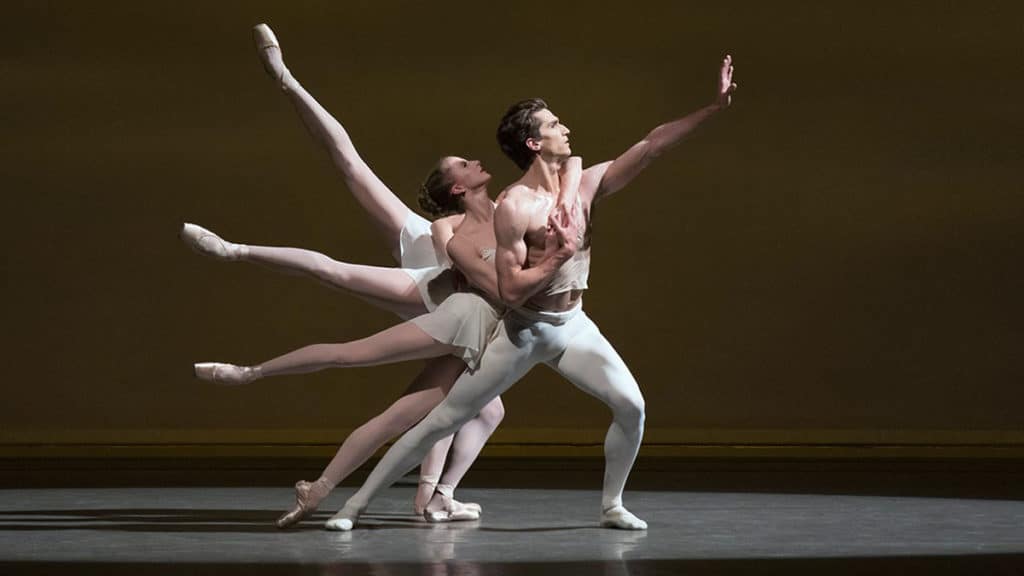New York City Ballet is one of the world’s leading ballet companies. Founding choreographer George Balanchine carried on from Ballets Russes, the Russian French dance company that relaunched ballet into the world from 1909-1929, and set in motion the transition from classical to neoclassical to contemporary ballet. Jerome Robbins, the other founding choreographer, brought his Broadway background into the mix.

Balanchine and Native American dancer Maria Tallchief, America’s first prima ballerina, turned “The Nutcracker” from an obscure piece into the world’s most popular ballet. Many City Ballet dancers become international stars, some become international choreographers, and some go on to lead America’s top ballet companies.
No other ballet company carries this legacy, and New York City Ballet continues working with new choreographers, artists, and designers on the future of dance. The 2023-24 Season features some great Latin Principals and Soloists. 🇺🇸 🇧🇷 🇵🇷 🇪🇸
Latin Principal dancers in the 2023-24 Season include:
- Jovani Furlan is a Principal from Joinville, Brazil. @jovani.furlan 🇧🇷
- Roman Mejia is a Soloist from Fort Worth, Texas. @roman.julian.mejia 🇺🇸
Latin Soloists in the 2023-24 Season include:
- Erica Pereira is a Soloist from Northport, New York. @peanutica 🇺🇸
- Aarón Sanz is a Soloist from Madrid, Spain. @aaronsmadrid 🇪🇸
- Sebastian Villarini-Velez is a Soloist from San Juan, Puerto Rico. @the_vinyl_seb 🇵🇷
New York City Ballet in New York City
April ~ June
David H. Koch Theater
New York City Ballet’s 75th Anniversary Spring Season includes classic programs of All Balanchine, Masters at Work, Spring Gala, Classic NYCB, All Stravinsky, and “A Midsummer Night’s Dream;” but looks to the future with Contemporary Choreography, Sensory-Friendly Performance programs; at the David H. Koch Theater in Lincoln Center; from April 23 to June 2, 2024. From $40. nycballet.com 🇺🇸 🇧🇷 🇵🇷 🇪🇸
The Spring Season opens with an All Balanchine program of “Bourrée Fantasque” (1949), “The Steadfast Tin Soldier” (1975), “Errante” (Formerly Tzigane, 1975), and “Symphony in C” (1947); in the David H. Koch Theater at Lincoln Center; on April 23-25, 30, and May 5, 2024. From $40. nycballet.com
Contemporary Choreography I program features the Jerome Robbins’ classic “Glass Pieces” (1983) to Philip Glass, Alexei Ratmansky’s “Pictures at an Exhibition” (2014) to Mussorgsky, Ulysses Dove’s “Red Angels” (1994) to Einhorn, and Gianna Reisen’s “Play Time” (2022) to Knowles. It’s at the David H. Koch Theater in Lincoln Center on May, 14, 18, 22, and 25, 2024. From $40. nycballet.com
If you’ve never seen “Glass Pieces,” it will blow your mind. It’s an intersection of all the crazy things happening in New York City in the early 1980s. The shape-shifting repetition of Glass’ music and surprising dance geometries reduce the rush hour energy of the Manhattan grid to a living Mondrian painting. The first time I saw it (as a guest of Suki Schorer), I just sat in the theatre and cried. It was so beautiful.
Contemporary Choreography II program features Pam Tanowitz’ “Law of Mosaics” (2022) to Hearne, Christopher Wheeldon’s “This Bitter Earth” (2012) to Richter and Otis, William Forsythe’s “Herman Schmerman (Pas de Deux)” (1992) to Willems, and Kyle Abraham’s “Love Letter (On Shuffle)” (2022) to Blake. It’s at the David H. Koch Theater in Lincoln Center on May 15, 19, 21, 23, 24, 2024. From $40. nycballet.com
Seasons
The Company dances fall, Nutcracker, winter, and spring seasons at the David H Koch Theater at Lincoln Center, and a summer season upstate in Saratoga Springs.
- Fall Season is usually September and October.
- Winter Season is usually January through March.
- “Nutcracker” Season is November and December.
- Spring Season is usually April through June.
- Summer Season is upstate in Saratoga Springs.
About New York City Ballet
When George Balanchine and Lincoln Kirstein started New York City Ballet in residence at New York City Center in 1948, few could have foreseen the impact they would have on American ballet – and the ballet world at large.
Balanchine brought his Imperial Ballet training, Ballets Russes background, and relationships with legendary ballet composers. Kirstein wanted Balanchine to be able to create freely, and Mr. B did. He continued the development of neoclassical ballet which he started as a choreographer at Ballets Russes in Paris. Mr B led the transition into contemporary ballet. He ultimately stripped away scenery, costume, and story; leaving black and white leotard ballets of pure movement.
Mr. B and America’s first prima ballerina, Maria Tallchief (Native American Osage Nation), turned an obscure work called “The Nutcracker” into the world’s most popular ballet, and an annual means of support for ballet companies around the world.
Balanchine carried on the Ballets Russes tradition of collaborating with the best artists of the day. He also helped plant the seeds for Dance Theatre of Harlem. His technique dominates the East Coast with Julie Kent leading Washington Ballet and Lourdes Lopez leading Miami City Ballet.
Jerome Robbins brought his Broadway background and a profound grasp of American culture. He loved African Diaspora dance traditions.
City Ballet carries on the Ballets Russes tradition of collaborating with the best artists of the day. The company’s School of American Ballet has a legacy of developing great dancers. In the end, it all comes down to music, choreography, and movement. That is probably exactly what Mr. B had in mind.
Apollo

“Apollo” (1928), the oldest ballet in City Ballet’s repertory, is the work that made George Balanchine famous. The story of Apollo’s coming-of-age under the influence of the muses, mirrors Mr. B’s own creative journey. The piece, choreographed for Sergie Diaghilev’s Ballets Russes, was when Balanchine decided that he didn’t have to hold tightly to tradition, that he could begin letting go. It was his own transition into creative maturity.
What is in that pose where four dancers become one in one of the most striking poses in all of ballet? We see Ubuntu, the South African concept that “I am because we are.” By himself, Balanchine was just a man. With dancers, he was a god, he became Apollo himself. I am because we are.
More Information
Twitter @nycballet
Facebook @nycballet
Instagram @nycballet
YouTube @nycballet
New York City Ballet Tickets
David H. Koch Theater
Lincoln Center
(left theater on the main plaza)
(212) 496-0600
Subway
(1) to 66th St – Lincoln Center
